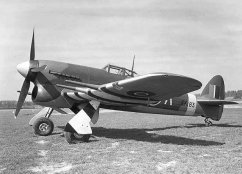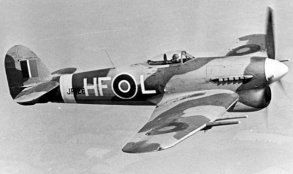
Hawker Typhoon
Although it first flew in 1940, the Hawker Typhoon did not come into its own until much later in the war. Rushed into service in 1941 as an Fw 190 destroyer, the Typhoon was fast enough to do the job but was not as agile as its foe, and its engine was plagued by reliability problems.
But as a low-level close support machine, the Typhoon was supreme. It was a superb gun platform and could carry and deliver with precision a heavy load of bombs or air to surface rockets.
The climax of the Typhoon's career came in the third week of August 1944 when all of the surviving German forces in northern France - 5th Panzer Army, 7th Army and Panzer Group 'Eberbach' - were caught in a trap near Falaise. Typhoons, mainly from the RAF's No. 83 Group, unleashed rockets, cannon shells and bombs until hardly one vehicle was capable of movement.
Once the war was over, the Typhoon's lack of reliability meant that the type was rapidly taken out of service. Only one Typhoon survives intact today.
An interceptor that failed, the Hawker Typhoon was nearly cancelled before it blossomed into the finest close support aircraft of World War II. With its pugnacious snub nose, four long barrelled cannon and whining Sabre engine, the big fighter-bomber wreaked havoc on its foes. Ranging far and wide over the battlefields of north-west Europe, swarms of Typhoons made an indelible mark on the history of warfare.
 |
 |
 |
| The Typhoon was designed in parallel with the Rolls-Royce Vulture-powered Tornado. |
Bomb-armed Typhoons were known as 'Bombphoons' and were very effective ground-attackers. |
Rocket-armed Typhoons were one of the most powerful weapons in the Allied inventory after D-Day, making life very difficult for German armoured forces fighting in France. |
|
Hawker Typhoon (Technical Specification) |
| Role |
Single-seat fighter-bomber |
| Manufacturer |
Hawker |
| Maximum Speed |
664 kmh (413 mph) |
| Maximum Range |
975 km (606 miles) |
| Ceiling |
10,700 meters (35,100 feet) |
Weight
Empty
Maximum Takeoff |
3,992 kg (8,800 lbs)
6,010 kg (13,250lbs) |
Dimensions
Wingspan
Length
Height
Wing Area |
12.67 meters (41 ft 7 in)
9.73 meters (31 ft 11 in)
4.52 meters (14 ft 10 in)
25.90 square meters (279 sq ft) |
| Engines |
One Napier Sabre IIA inline piston engine which provides 1,626-kW (2,180-hp) |
| Armament |
Four 20 mm (0.79 in) Hispano cannon each with 140 rounds
Two bombs of up to 454 kg (1,000 lbs) each or
Eight or twelve 27 kg (60 lbs) rockets or two 205 litres (45 gal) drop tanks |
Photo Gallery
Click here to submit your photo
| Have A Passion For Aircraft? |
|
|
|










